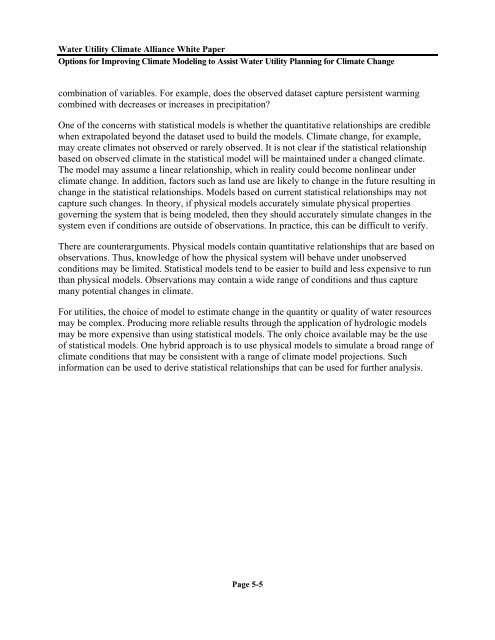Options for Improving Climate Modeling to Assist Water Utility ...
Options for Improving Climate Modeling to Assist Water Utility ...
Options for Improving Climate Modeling to Assist Water Utility ...
Create successful ePaper yourself
Turn your PDF publications into a flip-book with our unique Google optimized e-Paper software.
<strong>Water</strong> <strong>Utility</strong> <strong>Climate</strong> Alliance White Paper<br />
<strong>Options</strong> <strong>for</strong> <strong>Improving</strong> <strong>Climate</strong> <strong>Modeling</strong> <strong>to</strong> <strong>Assist</strong> <strong>Water</strong> <strong>Utility</strong> Planning <strong>for</strong> <strong>Climate</strong> Change<br />
combination of variables. For example, does the observed dataset capture persistent warming<br />
combined with decreases or increases in precipitation?<br />
One of the concerns with statistical models is whether the quantitative relationships are credible<br />
when extrapolated beyond the dataset used <strong>to</strong> build the models. <strong>Climate</strong> change, <strong>for</strong> example,<br />
may create climates not observed or rarely observed. It is not clear if the statistical relationship<br />
based on observed climate in the statistical model will be maintained under a changed climate.<br />
The model may assume a linear relationship, which in reality could become nonlinear under<br />
climate change. In addition, fac<strong>to</strong>rs such as land use are likely <strong>to</strong> change in the future resulting in<br />
change in the statistical relationships. Models based on current statistical relationships may not<br />
capture such changes. In theory, if physical models accurately simulate physical properties<br />
governing the system that is being modeled, then they should accurately simulate changes in the<br />
system even if conditions are outside of observations. In practice, this can be difficult <strong>to</strong> verify.<br />
There are counterarguments. Physical models contain quantitative relationships that are based on<br />
observations. Thus, knowledge of how the physical system will behave under unobserved<br />
conditions may be limited. Statistical models tend <strong>to</strong> be easier <strong>to</strong> build and less expensive <strong>to</strong> run<br />
than physical models. Observations may contain a wide range of conditions and thus capture<br />
many potential changes in climate.<br />
For utilities, the choice of model <strong>to</strong> estimate change in the quantity or quality of water resources<br />
may be complex. Producing more reliable results through the application of hydrologic models<br />
may be more expensive than using statistical models. The only choice available may be the use<br />
of statistical models. One hybrid approach is <strong>to</strong> use physical models <strong>to</strong> simulate a broad range of<br />
climate conditions that may be consistent with a range of climate model projections. Such<br />
in<strong>for</strong>mation can be used <strong>to</strong> derive statistical relationships that can be used <strong>for</strong> further analysis.<br />
Page 5-5

















